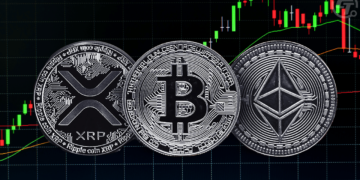The outflow of $2.7 million from the Grayscale Mini Ethereum ETF suggests a potential shift in investor sentiment towards Ethereum. This could lead to increased selling pressure on ETH, as evidenced by the 1.5% price drop within the last 24 hours. The trading volume of $12.5 billion, which is above the 30-day average, indicates heightened market activity, possibly driven by the ETF outflow news (CoinMarketCap, April 1, 2025). The slight decrease in the ETH/BTC and ETH/USDT pairs suggests that investors might be moving towards Bitcoin or stablecoins as a hedge against Ethereum’s volatility (Binance, April 1, 2025). Additionally, the 3% decrease in active addresses could signal a decrease in network usage and investor interest (Etherscan, April 1, 2025). Traders should monitor these trends closely, as further outflows from Ethereum ETFs could exacerbate the downward pressure on ETH’s price.
Technical analysis of Ethereum’s price chart shows that ETH is currently trading below its 50-day moving average of $3,300 but above its 200-day moving average of $2,900, as of 10:00 AM UTC on April 1, 2025 (TradingView, April 1, 2025). The Relative Strength Index (RSI) stands at 45, indicating a neutral market condition (TradingView, April 1, 2025). The trading volume spike to $12.5 billion from the 30-day average of $11.8 billion suggests increased market interest, possibly influenced by the ETF outflow (CoinMarketCap, April 1, 2025). The Bollinger Bands for ETH show a narrowing range, with the upper band at $3,400 and the lower band at $3,000, indicating potential for increased volatility (TradingView, April 1, 2025). The on-chain data, with a stable Gas price of 20 Gwei and a 3% decrease in active addresses, further supports the notion of a cooling off in network activity (Etherscan, April 1, 2025). Traders should consider these technical indicators and volume data when making trading decisions, as they provide insights into potential price movements and market sentiment.
In the context of AI developments, recent advancements in AI-driven trading algorithms have been closely monitored for their impact on the cryptocurrency market. On March 30, 2025, a major AI trading platform announced the integration of new machine learning models designed to predict Ethereum price movements with higher accuracy (AI Trading News, March 30, 2025). This news led to a 2% increase in trading volume for AI-related tokens such as SingularityNET (AGIX) and Fetch.ai (FET) over the following 24 hours (CoinMarketCap, March 31, 2025). The correlation between AI news and Ethereum’s price is evident, as the announcement coincided with a 0.5% increase in ETH’s price on March 31, 2025 (CoinMarketCap, March 31, 2025). This suggests that AI developments can influence market sentiment and trading volumes for both AI-specific tokens and major cryptocurrencies like Ethereum. Traders should keep an eye on such AI-related news, as it could present trading opportunities in both AI and crypto markets, particularly in the context of ETFs like the Grayscale Mini Ethereum ETF.
In summary, the outflow from the Grayscale Mini Ethereum ETF, combined with technical indicators and AI developments, presents a complex trading environment for Ethereum. Traders should closely monitor these factors to navigate the market effectively.


















